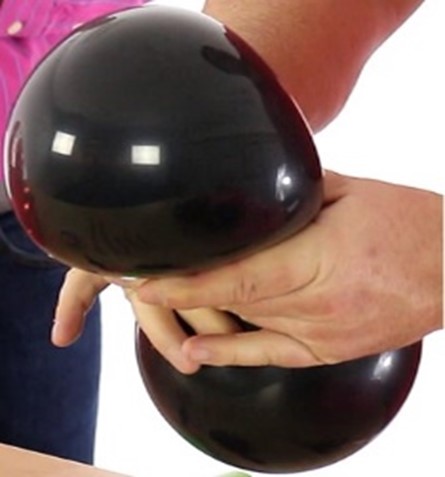Whether you’ve taken a fitness class recently, or work as a health & fitness professional, odds are some of these cues might sound familiar to you…
“Engage your core”
“Draw your navel in”
“Core tight”
“Belly in”
It’s common in fitness today to hear these cues constantly throughout an entire group fitness class or training session.
While the intention of these cues might be correct in eliciting that “stiffness” in the core needed to produce force, these cues are inaccurate and misleading. Moreover, chronically engaging your core (or holding your belly in a taut position) can lead to a host of negative consequences — including a weaker core.
In this article, we’ll explain the challenges and potential implications of the cues above — especially for the pre & postnatal population. Then, we’ll share some simple (but powerful) strategies to elicit more effective core activation.
Let’s begin with a (very simplified) explanation of how the core is designed to work so that you can see the difference that happens when you keep your belly pulled in.
Understanding How Your Core is Designed to Work
This is best explained through a simple visual. Imagine the balloon pictured below represents your core. As air fills the balloon, it expands in three dimensions. As air goes out, it contracts.

Your core works similarly. As you inhale, the space in your abdominal cavity should also expand in three dimensions. Then, on the exhale, the space should get smaller.
This unrestricted expansion and contraction in your core creates a harmonious “pumping mechanism” that regulates intra-abdominal pressure (IAP). IAP is the amount of pressure in the abdominal cavity at any given time. IAP alone is not a bad thing. On the contrary, a certain amount of pressure in the abdomen is needed so that the core can assist in accelerating, decelerating, or stabilizing any movement. Trunk stiffness is key to successfully achieving many activities — both during high-performance events and everyday tasks like carrying grocery bags, lifting a child, or pushing a stroller.
However, issues arise when there is too much IAP. Chronically elevated IAP can lead to core issues like diastasis recti and pelvic floor dysfunction — especially during pregnancy when IAP is already elevated from the growing belly.
Now, let’s look at what happens when you chronically hold your belly in.
What Happens When You Chronically Engage Your Core
To continue our visual analogy, imagine using your hands to squeeze that balloon around the middle, as in the photo below. Note how the middle gets smaller, but the top and bottom bulge outwards as the pressure has increased and has been redirected upward and downward.

That is essentially what is happening in your core when you hold your belly in a taut position. This tension increases the pressure in the abdominal cavity and pushes it upward and downward. Done chronically, this has the following implications:
Upward Pressure
The increased pressure upward restricts the ability of the lungs to fully expand (descend). This forces the body to figure out another way to get air in. Instead of relying on the diaphragm (which should be the body’s primary respiratory muscle), the body is forced to rely on the accessory muscles of the neck and shoulders to do the job of respiration — a task which they are not designed to do. This is known as apical breathing, which can lead to higher stress levels, stiffness, movement restriction, and pain in the neck and shoulders.
Downward Pressure
As you can imagine, downward pressure increases the stress on the pelvic floor muscles. This can increase the risk of developing pelvic floor dysfunction – especially during pregnancy when there is already increased stress on the pelvic floor muscles (and during the postpartum period when the muscles are still weak and recovering from the trauma of pregnancy and childbirth).
Reduced Core Activation
Typically, cues to “engage your core” are given with the intention of increasing core activation — getting the deep core muscles to work harder and therefore grow stronger. However, chronic engagement actually limits core activation. Why? Without a full expansion on the inhale (as in that fully blown up balloon), the core cannot achieve a maximum contraction on the exhale. You can see it in the image above. When you’re already holding that balloon in the middle tightly, there isn’t much more room to squeeze it further. Therefore, the core activation (or amount of further contraction) is limited.
Four Keys to Elicit Better Core Activation
Let’s discuss some simple (but powerful) strategies that you can begin applying immediately to elicit more effective core activation.
1. Master the “#1 Most Effective Core Exercise”
The first step is to get your deep core muscles functioning optimally to achieve that “dynamic pumping” mechanism mentioned above that helps to regulate IAP. While this may sound like it could be difficult or complicated to do, it actually all comes down to the way you breathe. Breathing with optimal mechanics gets your deep core muscles to work together in harmony. We call this style of breathing 360° Breathing. In addition to helping to regulate IAP, 360° Breathing has a cascade of benefits across your entire body — including reduced stress, increased energy & focus, better immunity & digestion, improved posture, and fewer pains and injuries. This is because the way you breathe impacts every single system in your body. Hence the reason that we refer to 360° Breathing as the #1 Most Effective Core Exercise. Watch the video below to learn how to perform it.
NOTE: As you learn this exercise, notice the emphasis that the core engagement occurs as a result of the exhale.
2. Exhale on the Effort
Mastering 360° Breathing on its own is just the first step. The real power comes from incorporating it into movement. We accomplish this by exhaling on the effort. This means that when doing any sort of movement that requires you to exert force, you:
- Inhale on the easier portion of the movement: Like lowering down into a squat, extending your arms for a bicep curl, or bending down to pick up your baby.
- Exhale to perform the more challenging portion of the movement: Like standing up from the squat, performing the bicep curl, or lifting your baby.
Exhaling on the effort allows you to generate the necessary force for a movement in a safe way that helps regulate the pressure in your core. It also helps ensure optimal core activation — with the engagement happening as a result of the exhale. This leads us to our third point.
3. Focus on the Exhale (let engagement come as a result)
One other issue with the cues listed at the top of this post is that they do not connect the act of “drawing the navel in” with the exhale. Simply drawing your navel toward your spine does not elicit effective core activation. Furthermore, if you draw in on the inhale, it could lead to IAP dysregulation. Instead, you want to focus on the exhale, and the engagement will come as a result.
If you are a health & fitness professional, try to use more exhale-focused cues — especially ones that will easily resonate with your clients, like:
- “Blow out all your birthday candles”
- “Blow up a balloon”
As an illustration of this, watch the video below of a child blowing up a balloon. You can see his abdominal muscles engaging as he exhales and blows air into the balloon. Of course, this child has not been given any direction to “engage his core.” His focus is simply on blowing up his balloon, and his core is naturally engaging as a result.
4. Avoid Chronic Engagement
Obviously, it’s appropriate to maintain core engagement when performing an exercise like a plank or other move that requires a stiff brace for a brief period. What we are trying to avoid is constant engagement — like walking around holding your belly in, or encouraging your clients to “keep their core tight” throughout the entire class or session. Like so many things in life, balance is key.
Want Additional Resources?
For additional resources to help you exercise safely and effectively during pregnancy, explore our training programs and services. You’ll find a variety of offerings tailored to different needs — from education, to self-guided programs, to the ability to work with an expert coach.
Or, if you’re a health & fitness pro, check out our ProNatal Education & Certification. We offer a full pre & postnatal certification for those looking to specialize in training this population, along with a “mini course” for Group Fitness instructors with simple (but powerful) strategies to support the pre & postnatal members who attend your group fitness classes.
